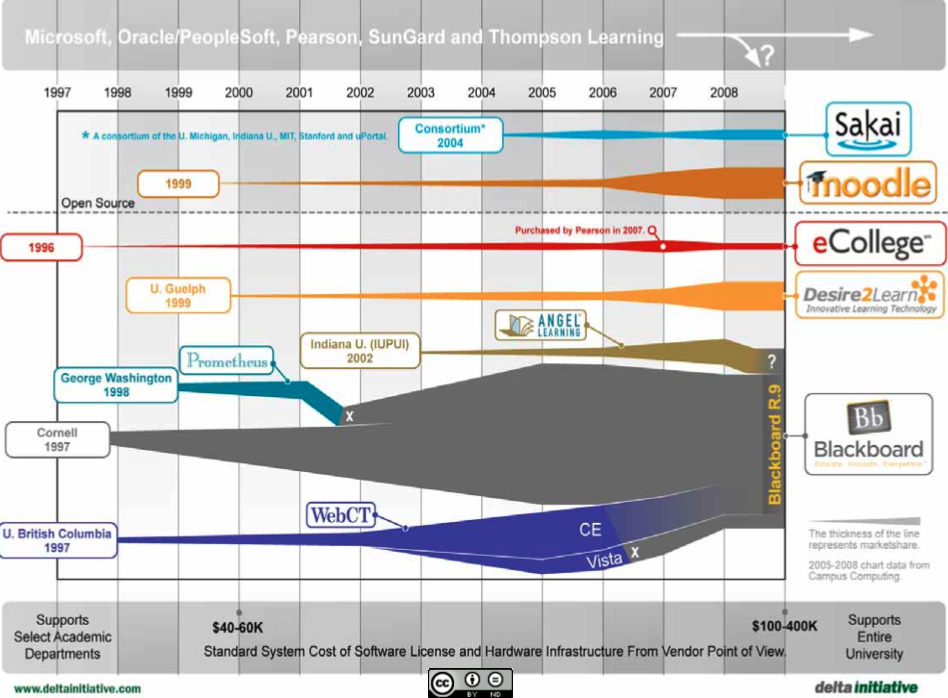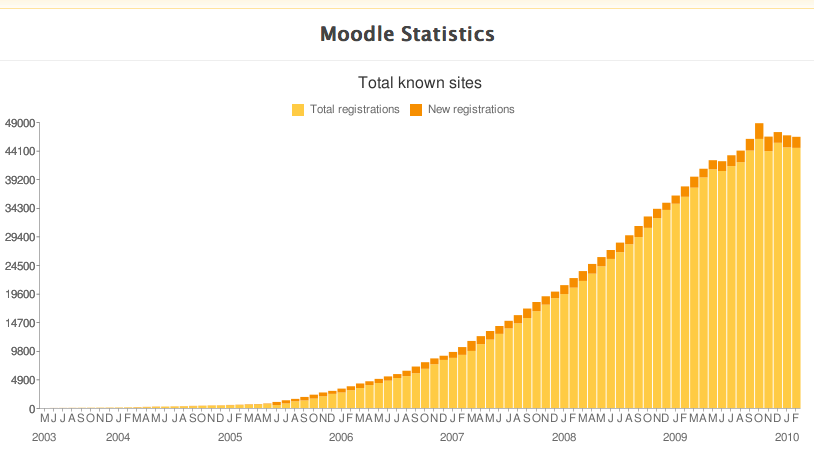E-learning concepts - Table of Content
TOC of Lecture notes, readings, exercises
E-learning
solutions
 Learning Objectives
Learning Objectives
When you have completed this session, you should be able to
- list a range of worldwide used solutions for LMS and LCMS systems
- list the main features of one of the open source LMS systems – Moodle
There are a large number of framework solutions available for implementing electronic learning environments.

Multinational IT companies (for example Microsoft, Cisco, IBM, SAP and Oracle) provide e-learning solutions of various complexities. There are also specialized providers of e-learning solutions. These specialized providers can be either multinational suppliers or national suppliers. The national suppliers tend to exploit local differences in the learning landscape. Most of these private suppliers of solutions tend to be closed, in the sense that the solution is designed to fit the complete needs of an organization.
There are also new entrants to the market coming from the open source community. These solutions tend to come from publicly funded projects, or from academic research activity.
There is an obvious and large difference between the design of Open source solutions and proprietary solutions. The open source solutions tend to be developed by a network or community of developer across the web. Proprietary solutions tend to be developed by a single laboratory, looking after the needs of the owners.
Whatever technology is implemented by an organization, there are always costs to be paid. These costs include licenses, installation and maintenance, and the payroll costs of all of the people working on the platform.
Today, the level of professionalism exhibited by both open source and proprietary solutions are comparable. There are a multitude of suppliers of e-learning tools, platforms, and services. The magazine e-Learning Age lists 27 suppliers of LCMS and 150 suppliers of LMS solutions at www.elearningage.co.uk/suppliers.aspx (accessed 1/4/2010). The Tenegen Community has worked with the following systems.
Sulinet Digital Learning Base (http://sdt.sulinet.hu/)
The Hungarian organization, Sulinet, won a Comenius-Edumedia-Award in 2007. This is awarded by the Society for Pedagogy and Information (GPI), a scientific society for multimedia, educational technology and media didactics, for outstanding products in the field of ICT-supported educational media. www.sulinet.hu/tart/cikk/Rca/0/31710/1. The honor was received in Berlin by the representatives the Hungarian Education Community Service Public Company and Sulinet Program Office.
The SDT Digital Learning Database is a repository of digital learning materials. In the SDT teachers and students of general secondary and vocational schools find many thousands of digital learning materials, and teachers are invited to collaborate, and to extend the database with their own digital educational products.
Moodle (https://moodle.org/)
Moodle was initially designed and distributed by Martin Dougiamas in 1999. Dougiamas is an Australian developer and scientific researcher. It is released as an open source-code system providing learning and content management. The aim of Moodle was to develop a new system which, contrary to first generation framework systems, supports cooperation between teachers and students. It is very interesting to examine how this application has become so widespread in so short a time. It could be that this is a result of its excellent technical features:
|
 |
More and more institutes have joined the community of Moodle users. The growth in its number of users and sites can be seen by the accompanying figure from moodle.org/stats/ (accessed 1/4/2010).
ILIAS (http://www.ilias.de/docu/goto_docu_root_1.html)
ILIAS is a web based e-learning framework system to support learning materials and it providing both LMS and LCMS service. It is being developed with the coordination of the University of Köln (based on PHP, MySQL). Since September 2000 it has been distributed as open source-code software. It is worth checking it application statistics. The sourceforge (https://sourceforge.net/) statistics are here - www.ohloh.net/p/ilias?ref=WidgetProjectThinBadge. (accessed 01/04/2010). There are 95 logged downloads for ILIAS. Ilias also has statistics at www.ilias.de/docu/goto_docu_lm_470.html (accessed 01/04/2010).
Blackboard (http://uki.blackboard.com/)
The first version of e-learning products was branded Blackboard CourseInfo LLC in 2000. Blackboard went public in June 2004. Blackboard software is used by over 3,700 education institutions in more than 60 countries, and is the selection of choice by system administrators. This is proprietary software, and has significant capital costs associated with it.
 Exercises
Exercises
1. Visit the Wikipedia site of your country and search for "LMS". Try to find the e-learning solution which is most used in your country, and write a short report about you learned, discuss your report on your learning diary.
References
1. The development of Sulinet Digital Learning Base started in 2004 with the support of the Hungarian government. SDT is an e-learning framework system fits for the Hungarian Public Educational System. It can be used free of charge. Currently it contains more than 11 000 (mainly secondary school) general and vocational lessons and lesson supplements. www.sulinet.hu/tart/kat/Se (accessed 01/04/2010).